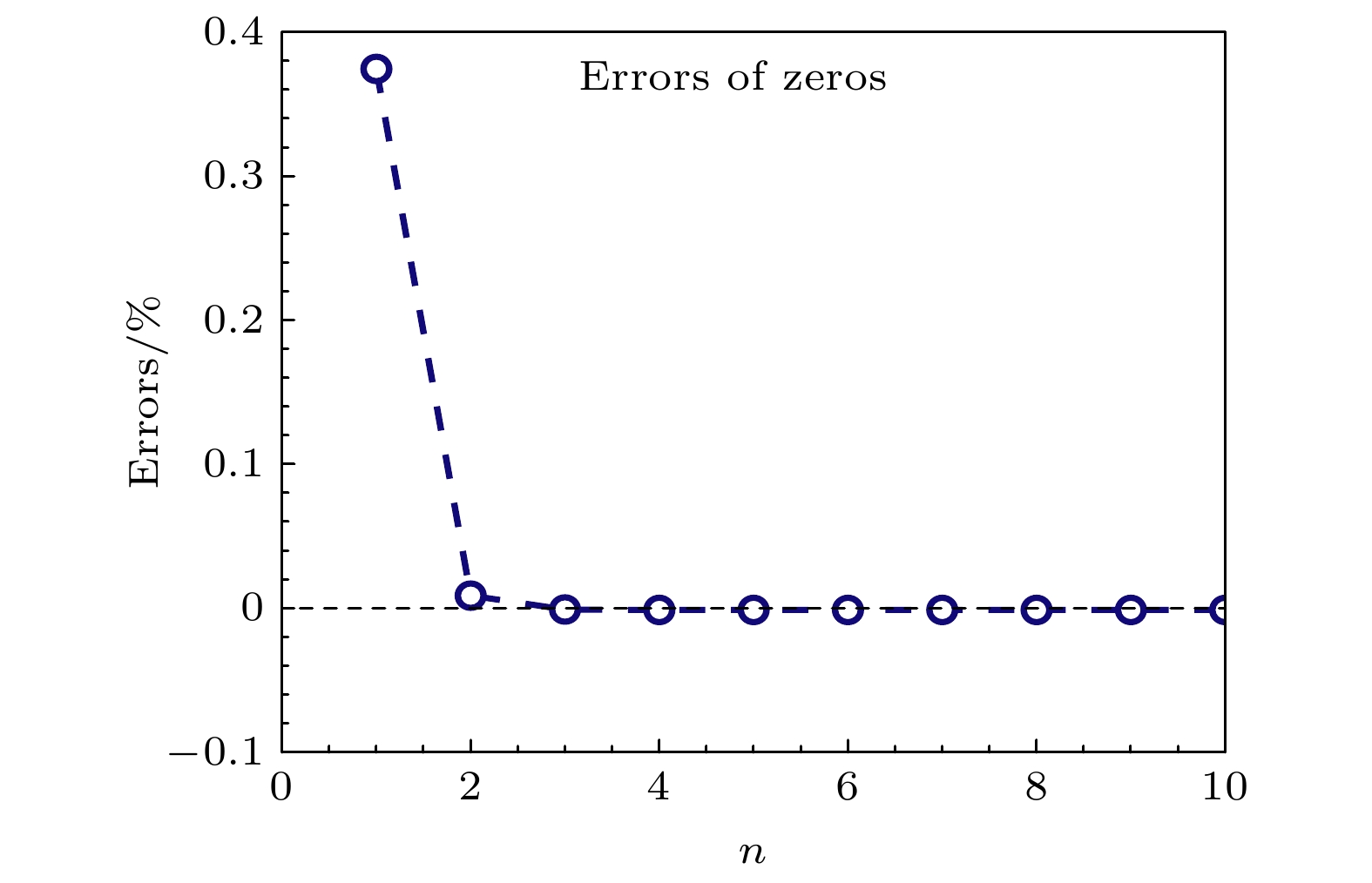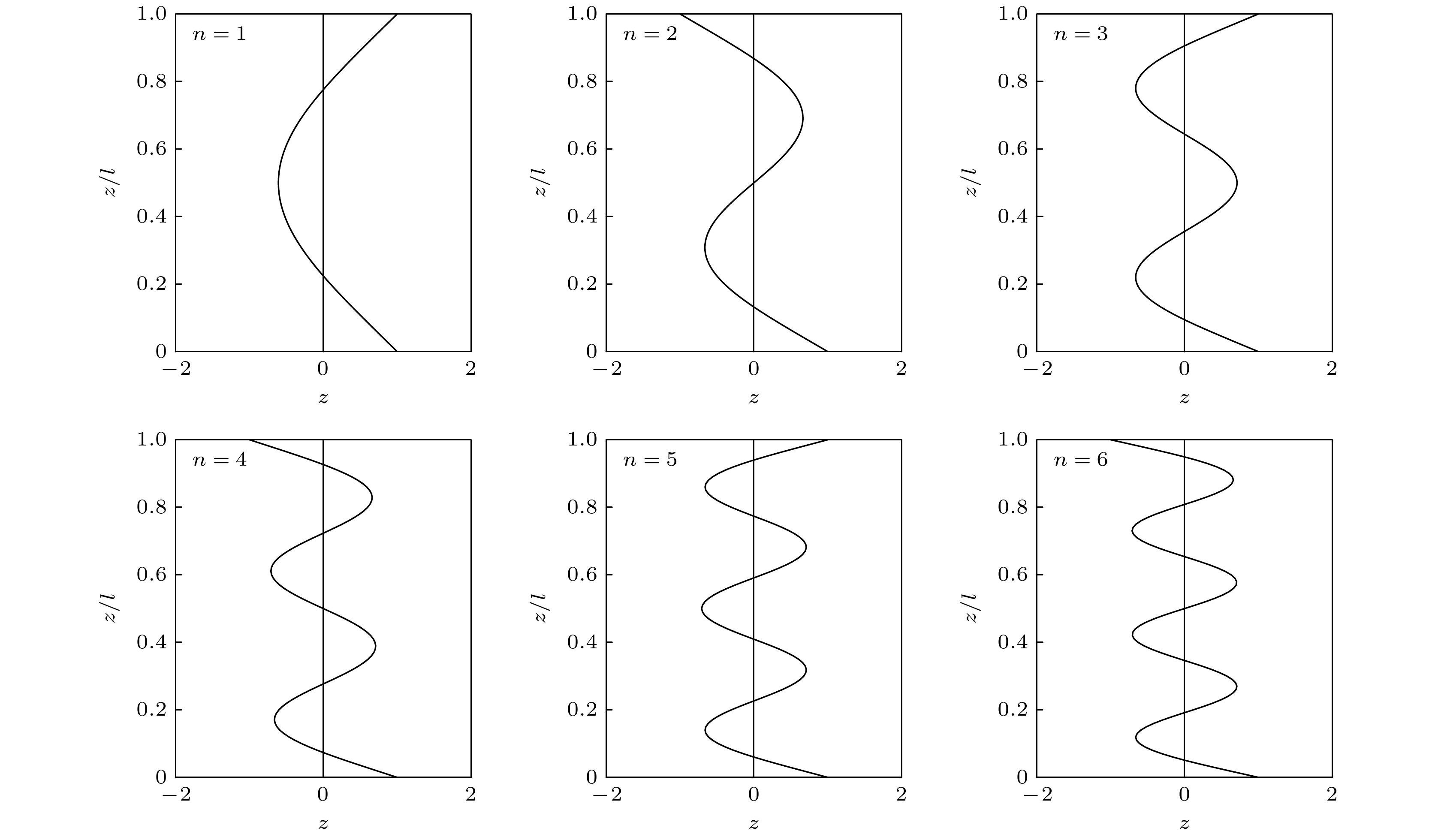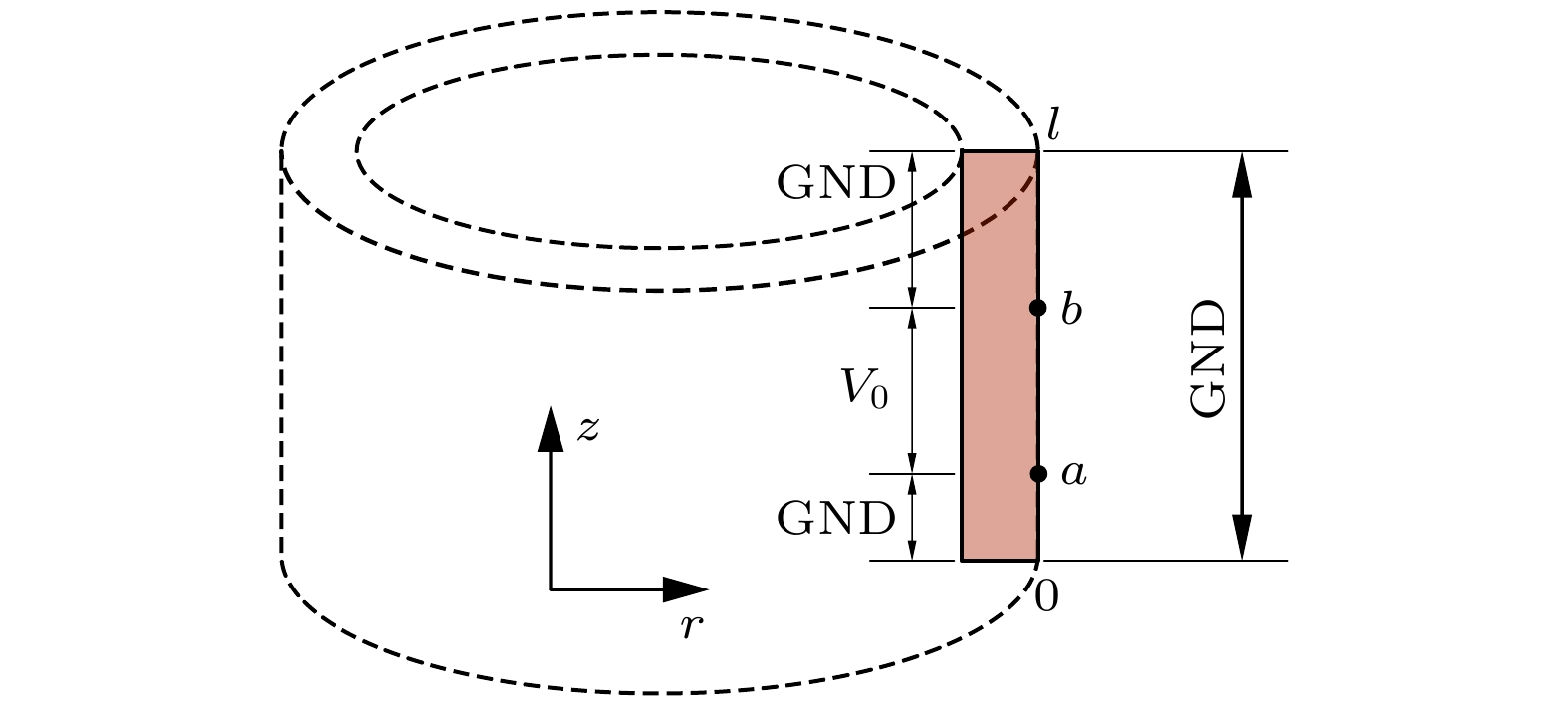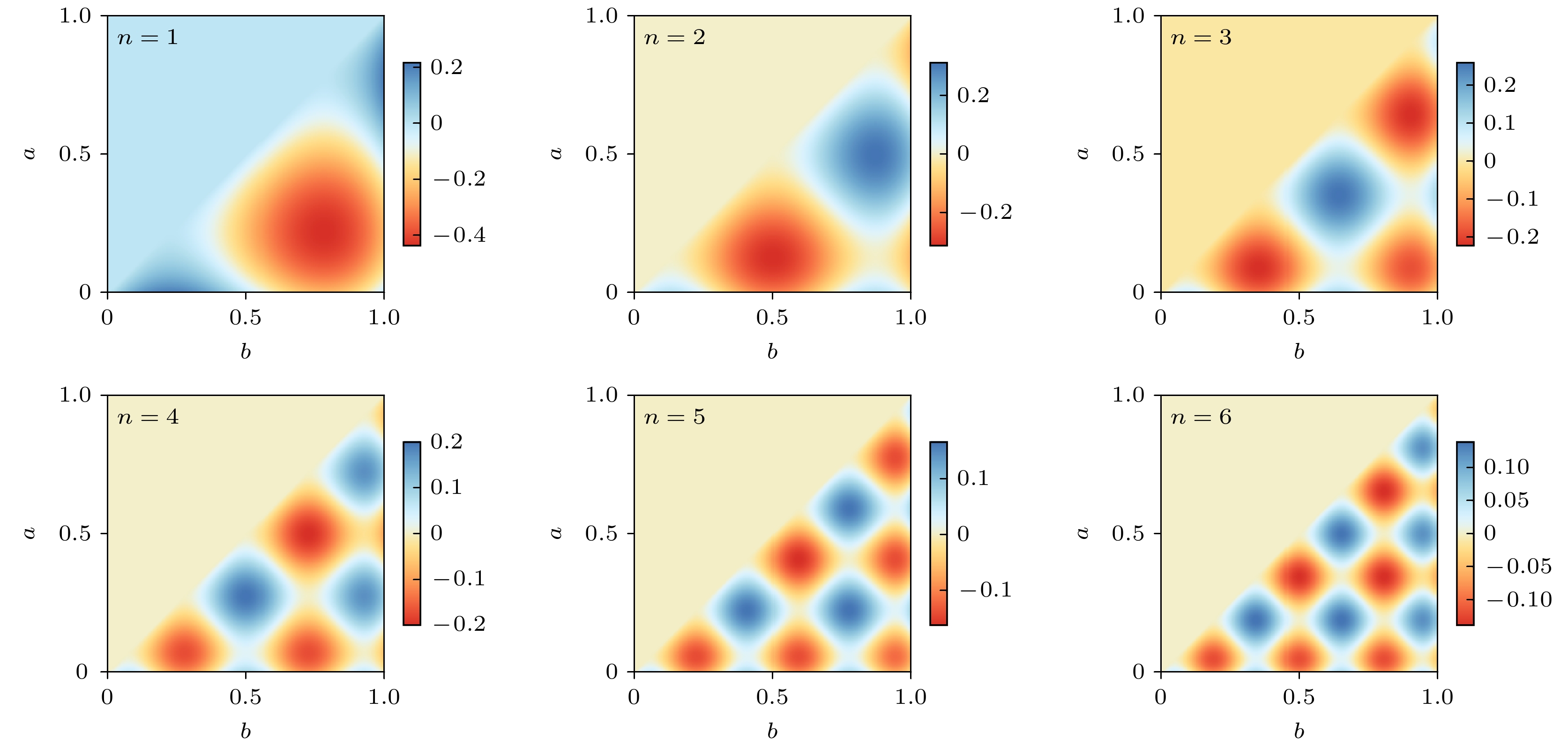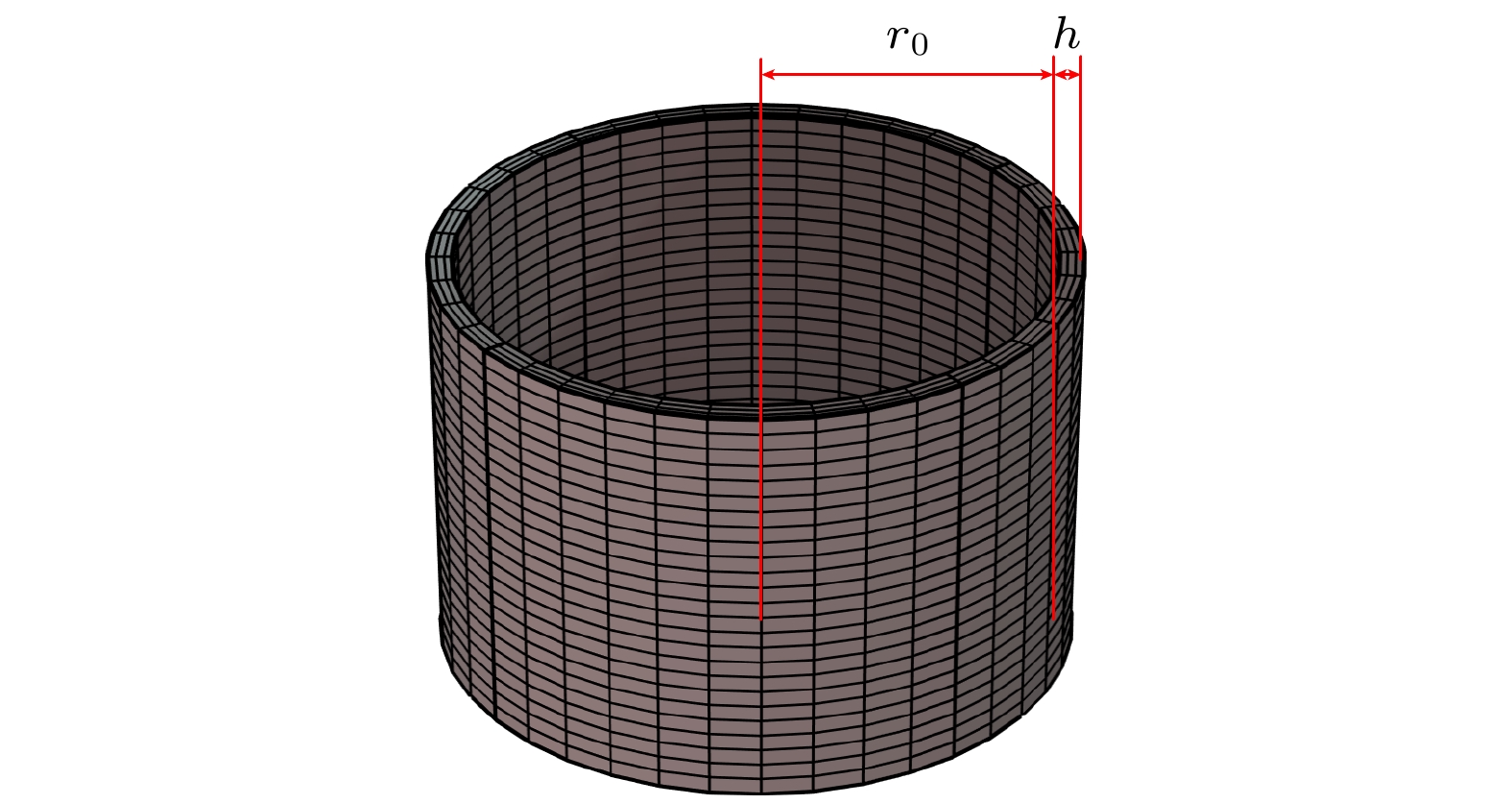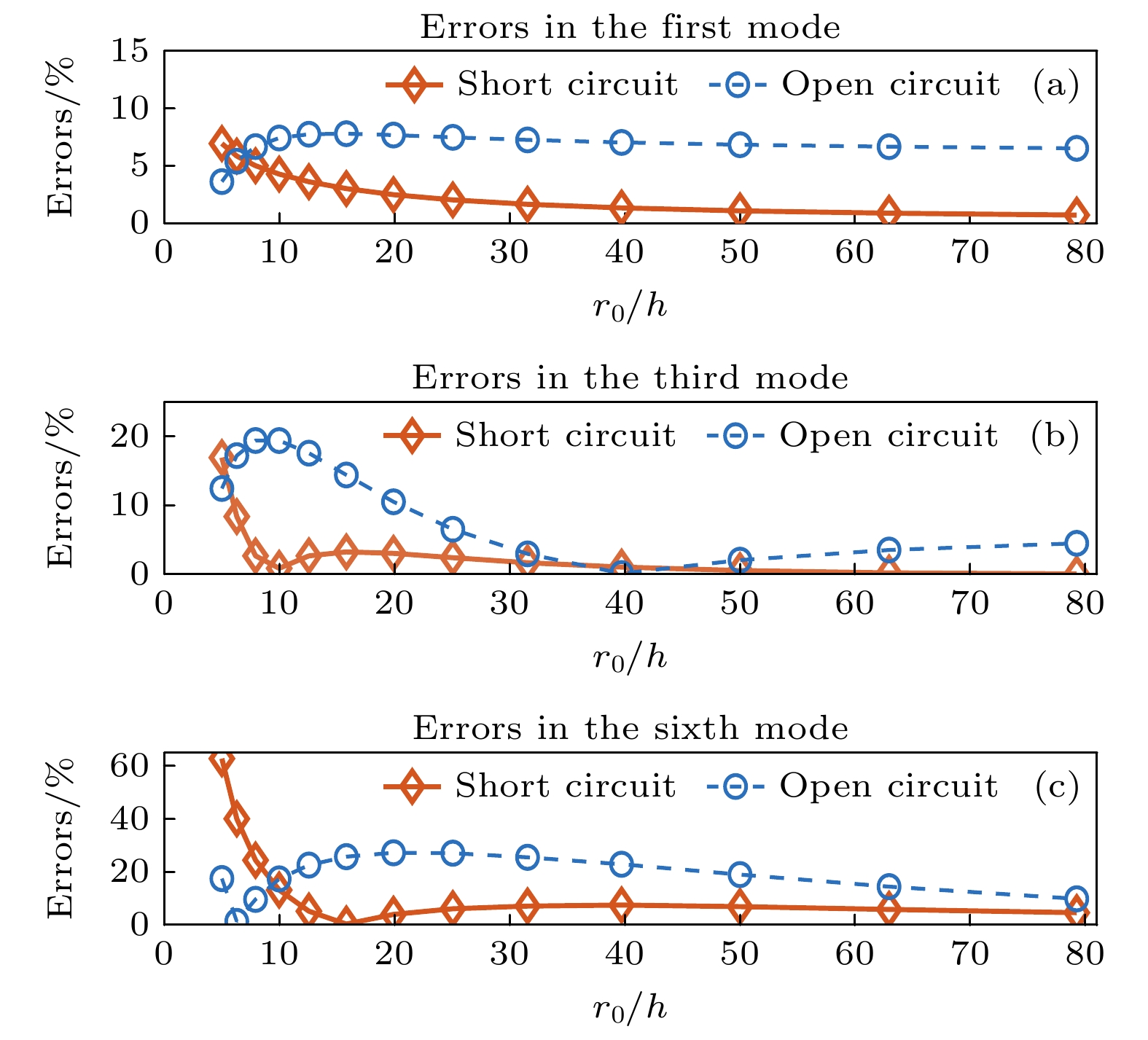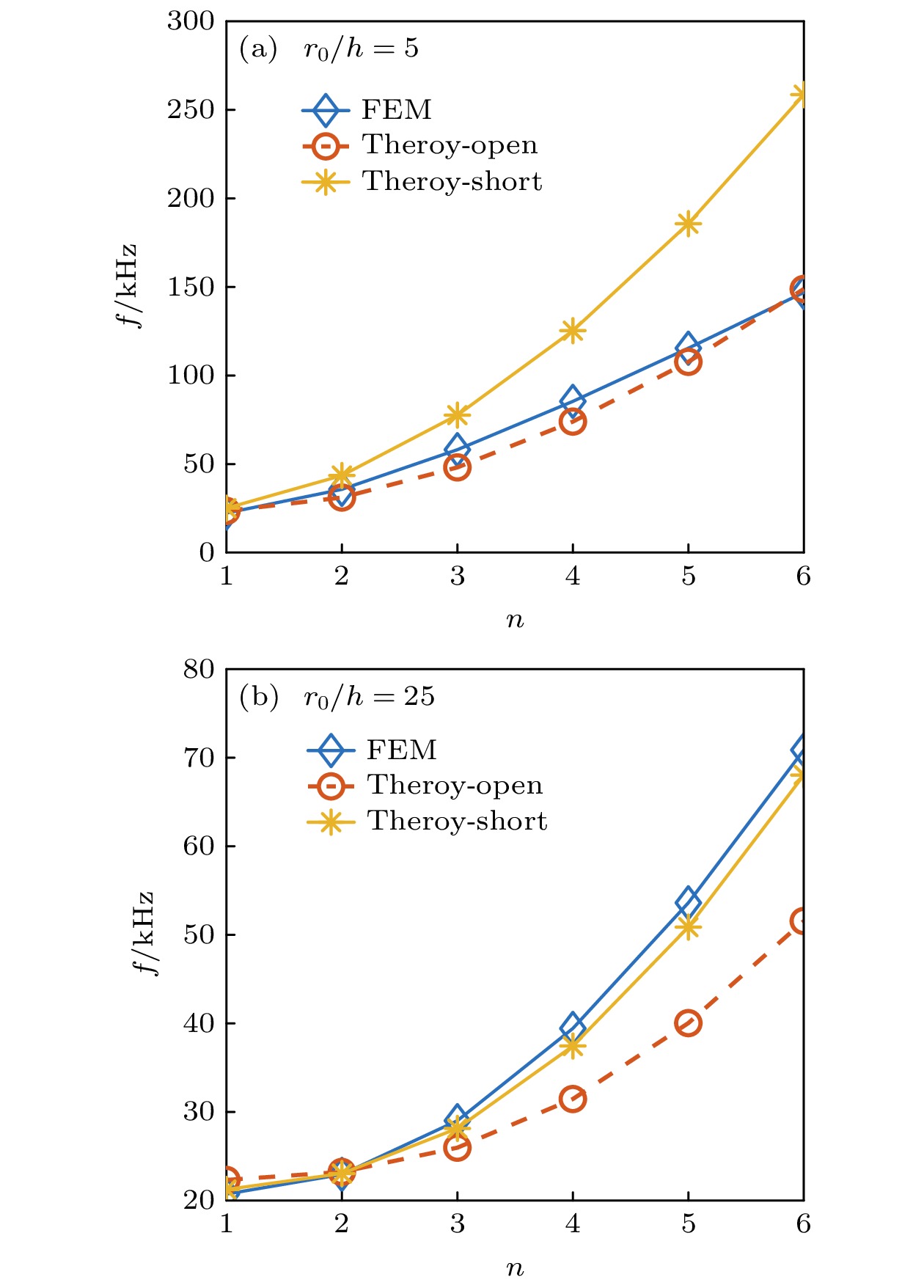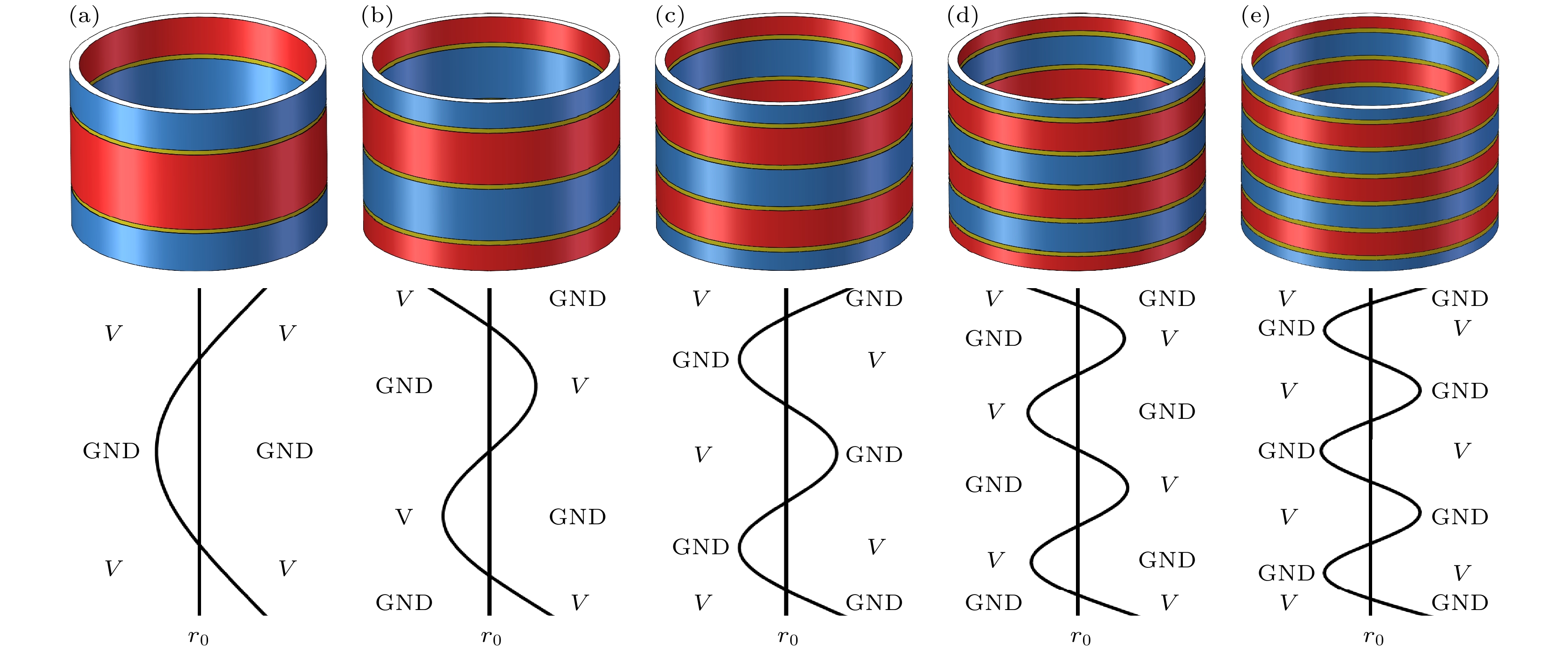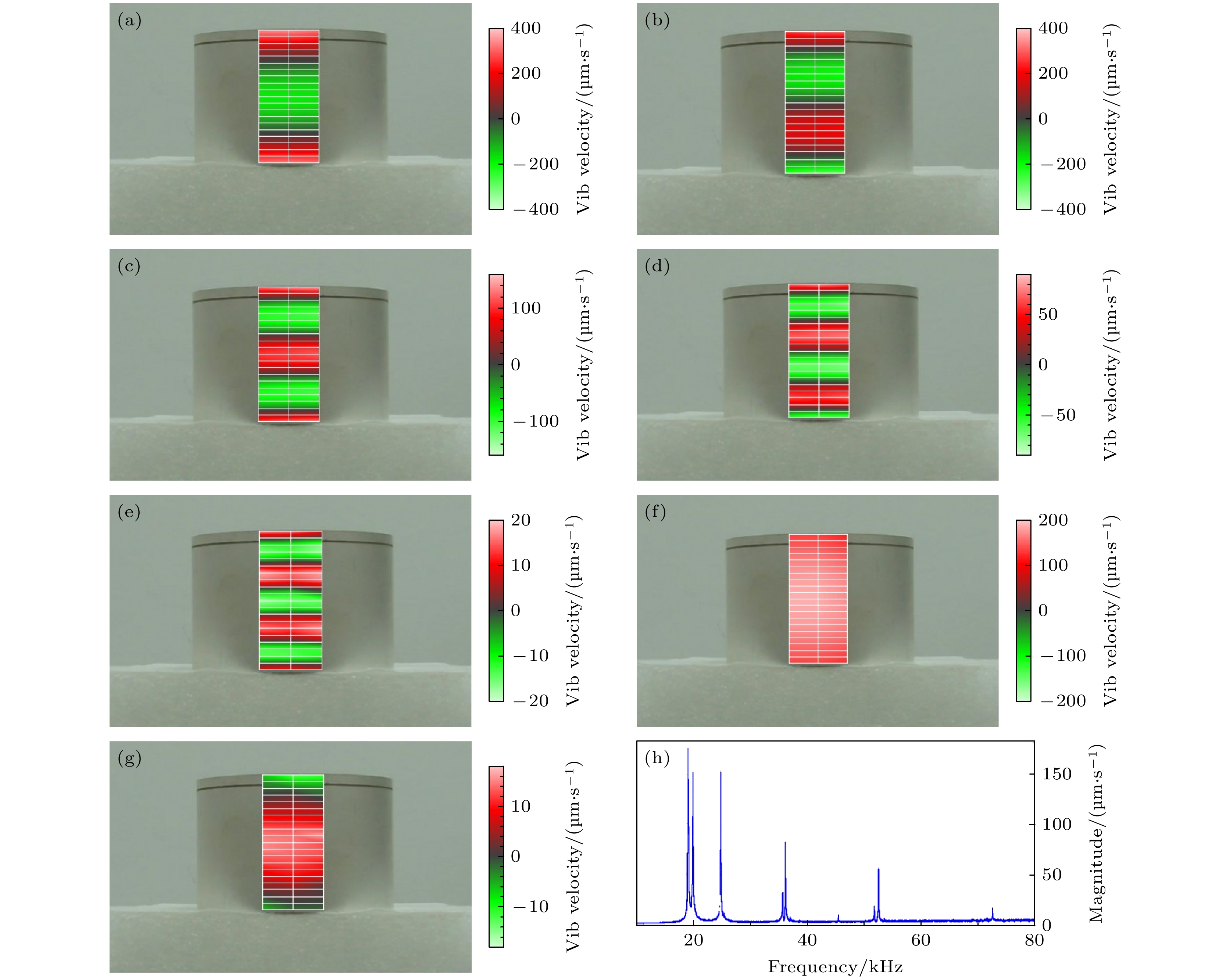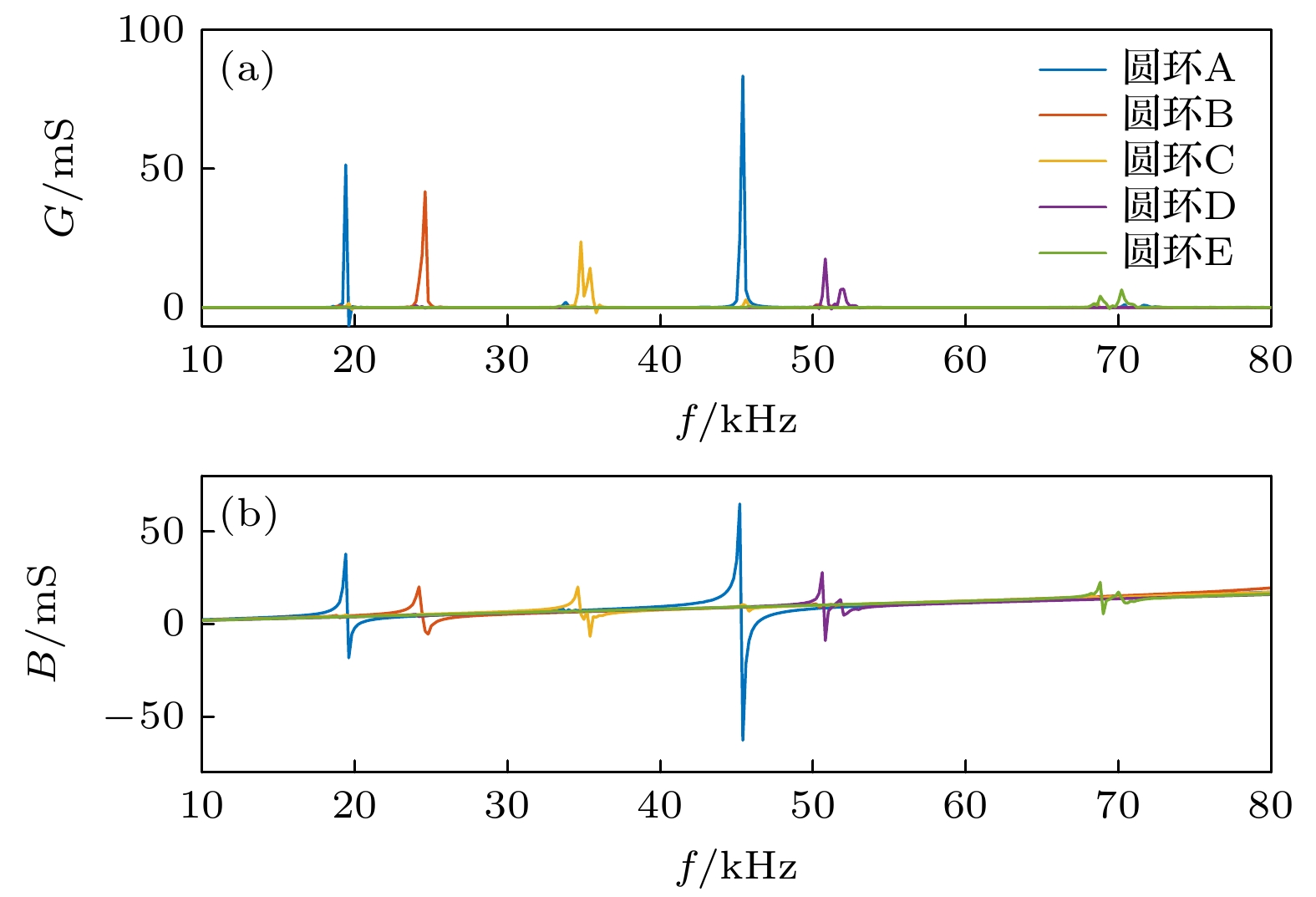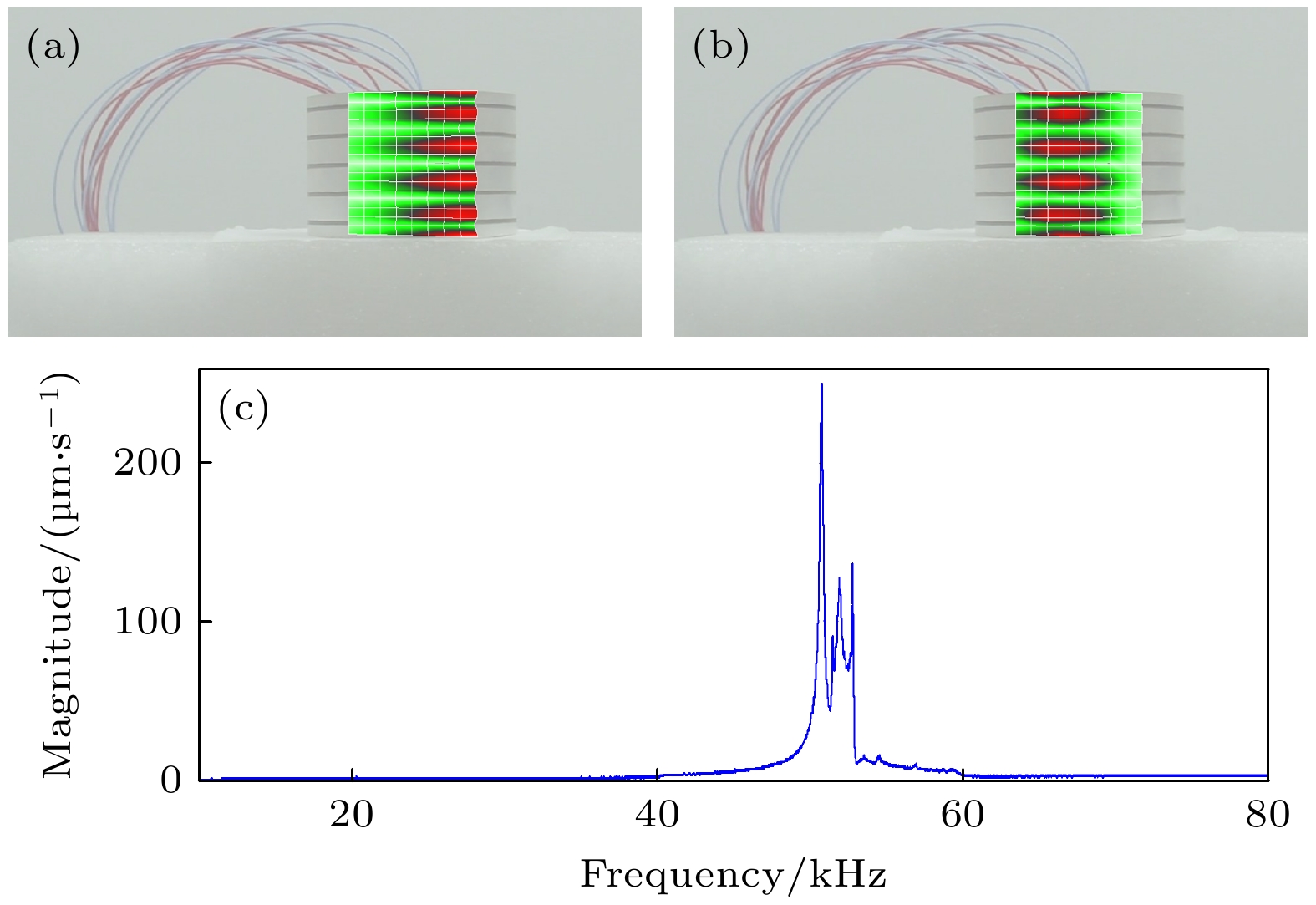-
Piezoelectric ring transducer is one of the most common underwater transducers, and its radial vibration, bending vibration in-plane $r \text- \theta $ and out-of-plane $r \text- \theta $ have been widely studied. However, the current research on the bending vibration in the plane $r \text- z$ of the ring is insufficient, although it may have a noticeable influence on the applicability of the underwater transducers. In this study, mechanical analysis and related mathematical calculations of the bending vibrations in the plane $r \text- z$ are carried out by using the thin-shell theory. Herein, the following three aspects are studied: 1) free vibration theory solution, 2) forced vibration: multi-order modal excitation theory, and 3) related finite element calculations and experimental verification. In this study, the bending vibration equations under electrical short and electric open condition are derived, and the multi-order resonance frequency prediction formulas and shape functions for both conditions are obtained by analytical solution and function fitting. Using the finite element method, the influence of piezoelectric effect and the range of applicability of these two electrical conditions are analyzed. The non-homogeneous equations under forced vibration are solved. By utilizing the orthogonal completeness of the vibration mode function, an integral transformation with the vibration mode function can be defined as the basis vector, so that the equation is solved in a simple positive space, and the results reveal the relationship between the coefficients of the modes of different orders and the voltage distribution. By modal theory, the effects of electrical excitation conditions on the multistep bending vibration modes are investigated, and effective methods such as unimodal excitation, partial excitation and single-ended excitation acting on several different target modes are obtained. The proposed piezoelectric ring unimodal excitation and single-ended excitation methods successfully excite the target modes in the experiments: the unimodal excited ring excites only one of its corresponding bending modes, while the single-ended excitation method excites all the bending modes of the first five orders, and its modal strength characteristics are in accordance with the theoretical predictions. This study involves finite element simulation, experimental and theoretical comparative verification, which are in good agreement. The relevant conclusions can provide a theoretical basis for identifying the vibration modes of piezoelectric ring and the fine tuning of modal excitation.
[1] Butler J L, Sherman C H 2016 Transducers and Arrays for Underwater Sound (Cham: Springer International Publishing) p191
[2] 滕舵, 王龑, 解柯柯 2018 陕西师范大学学报(自然科学版) 46 30
 Google Scholar
Google Scholar
Teng D, Wang Y, Xie K K 2018 J. Shaanxi Norm. Uni. (Nat. Sci. Ed. ) 46 30
 Google Scholar
Google Scholar
[3] 周利生, 许欣然 2021 声学学报 46 1250
 Google Scholar
Google Scholar
Zhou L S, Xu X R 2021 Acta Acust. 46 1250
 Google Scholar
Google Scholar
[4] 张鸿磊 2018 硕士学位论文 (哈尔滨: 哈尔滨工程大学)
Zhang H L 2018 M. S. Thesis (Harbin: Harbin Engineering University
[5] 柴勇, 莫喜平, 刘永平, 潘耀宗, 张运强, 李鹏 2017 声学学报 42 619
 Google Scholar
Google Scholar
Chai Y, Mo X P, Liu Y P, Pan Y Z, Zhang Y Q 2017 Acta Acust. 42 619
 Google Scholar
Google Scholar
[6] 宋哲, 严由嵘 2018 水下无人系统学报 26 498
Song Z, Yan Y R 2018 J. Unmanned Underw. Systems 26 498
[7] 林书玉 2023 声学学报 28 102
 Google Scholar
Google Scholar
Lin S Y 2023 Acta Acust. 28 102
 Google Scholar
Google Scholar
[8] 穆廷荣 1979 声学学报 3 161
 Google Scholar
Google Scholar
Mu Y R 1979 Acta Acust. 3 161
 Google Scholar
Google Scholar
[9] Been K, Nam S, Lee H, Seo H seon, Moon W 2017 J. Acoust. Soc. Am. 141 4740
 Google Scholar
Google Scholar
[10] Lee J, Been K, Moon W 2023 J. Acoust. Soc. Am. 154 A228
 Google Scholar
Google Scholar
[11] Rogers P H 2005 J. Acoust. Soc. Am. 77 S16
 Google Scholar
Google Scholar
[12] Butler J L 1976 J. Acoust. Soc. Am. 59 480
 Google Scholar
Google Scholar
[13] Sherman C H, Parke N G 2005 J. Acoust. Soc. Am. 38 715
 Google Scholar
Google Scholar
[14] Huang C H, Ma C C, Lin Y C 2005 IEEE Trans. Ultrason. Ferroelect. Freq. Contr. 52 1204
 Google Scholar
Google Scholar
[15] Aronov B S 2013 J. Acoust. Soc. Am. 134 1021
 Google Scholar
Google Scholar
[16] 胡久龄 2023 博士学位论文 (哈尔滨: 哈尔滨工程大学)
Hu J L 2023 Ph. D. Dissertation (Harbin: Harbin Engineering University
[17] 滕舵 2016 水声换能器基础 第233页
Teng D 2016 Fundamentals of Hydroacoustic Transducers (Northwestern Polytechnical University Press) p233
[18] Timošenko S P, Woinowsky-Krieger S 1996 Theory of Plates and Shells (New York: McGraw-Hill) p580
[19] 曹志远 1989 板壳振动理论 (北京: 中国铁道出版社) 第462页
Cao Z Y 1989 Plate and Shell Vibration Theory (Beijing: China Railway Press) p462
[20] 栾桂冬 2005 压电换能器和换能器阵 (北京: 北京大学出版社) 第479页
Luan G D 2005 Piezoelectric Transducers and Transducer Arrays (Beijing: Peking University Press) p479
[21] 潘瑞, 柴勇, 莫喜平, 刘文钊, 张秀侦 2024 应用声学 43 719
 Google Scholar
Google Scholar
Pan R, Chai Y, Mo X P, Liu W Z, Zhang X Z 2024 Appl. Acoust. 43 719
 Google Scholar
Google Scholar
[22] 张海澜 2012 理论声学(北京: 高等教育出版社) 第139页
Zhang H L 2012 Theoretical Acoustics (Beijing: Higher Education Press) p139
[23] 单影, 许龙, 周光平 2022 压电与声光 44 316
 Google Scholar
Google Scholar
Dan Y, Xu L, Zhou G P 2022 Piezoelectr. Acoustoopt. 44 316
 Google Scholar
Google Scholar
-
图 16 单端激励的激光测振图 (a) f = 19656 Hz; (b) f = 24656 Hz; (c) f = 36094 Hz; (d) f = 52594 Hz; (e) f = 72813 kHz; (f) f = 18750 Hz; (g) f = 45500 Hz; (h) 平均振速幅频响应
Fig. 16. Vibration with single-ended excitation: (a) f = 19656 Hz; (b) f = 24656 Hz; (c) f = 36094 Hz; (d) f = 52594 Hz; (e) f = 72813 kHz; (f) f = 18750 Hz; (g) f = 45500 Hz; (h) mean amplitude-frequency response of the vibration rate.
图 17 单端激励实验电导曲线及谐振频率 (a) 单端激励、全激励电导曲线与理论计算弯曲谐振频率; (b) 理论计算、有限元仿真与实验的谐振频率对比
Fig. 17. Experimental conductance curves and resonance frequencies for single-ended excitation: (a) Single-ended excitation, full excitation conductance curves and theoretically calculated bending resonance frequencies; (b) comparison of theoretically calculated, finite element simulation and experimental resonance frequencies.
表 1 n阶模态对应的第m个节点位置z/l
Table 1. The m-th node positions z/l corresponding to n-th order modes.
n m 1 2 3 4 5 6 7 1 0.2250 0.7788 — — — — — 2 0.1321 0.5000 0.8677 — — — — 3 0.0944 0.3558 0.6441 0.9076 — — — 4 0.0735 0.2768 0.4997 0.7298 0.8749 — — 5 0.0601 0.2265 0.4091 0.5909 0.7727 0.9545 — 6 0.0509 0.1916 0.3462 0.5000 0.6538 0.8077 0.9615 表 2 单端激励激发出前n阶模态对应激励长度
Table 2. Excitation lengths of the first n order modes with single-ended excitation.
n 1 2 3 4 5 $ b/{l_{\max }} $ 0.5019 0.2904 0.2077 0.1616 0.1322 表 3 PZT-46压电陶瓷的材料参数
Table 3. Material parameters of PZT-46 piezoelectric ceramics.
$ s_{11}^{\text{E}}/{\text{P}}{{\text{a}}^{ - {1}}} $ $ \rho /({\text{kg}} {\cdot} {{\text{m}}^{ - {3}}}) $ $ \varepsilon _{{33}}^{\text{T}}/({\text{F}} {\cdot} {{\text{m}}^{ - {1}}}) $ $ {d_{31}}/\left( {{\text{C}} {\cdot} {{\text{N}}^{ - {1}}}} \right) $ $ {d_{15}}/ ({{\text{C}} {\cdot} {{\text{N}}^{-{1}}}}) $ ${v_{12}}$ ${k_{31}}$ 14.31×10–12 7750 11.51×10–9 –1.56×10–10 4.96×10–10 0.33 0.365 表 4 前五阶弯曲模态谐振频率对比
Table 4. Comparison of the first five orders resonance frequencies of bending modes.
阶数n 实验/Hz FEM/Hz 理论/Hz FEM误差/% 理论误差/% 1 19656 19423 19795 1.19 0.71 2 24656 24162 24192 2.00 1.88 3 36094 35537 34881 1.54 3.36 4 52594 52182 51921 0.78 1.28 5 72813 72685 74623 0.18 2.49 表 A1 径厚比${r_0}/h$对电学开路与电学短路理论的影响
Table A1. Influence of diameter to thickness ratio on the theory of electrical open circuit and electrical short circuit.
阶数 ${r_0}/h$ 5.0 6.3 7.9 10.0 12.6 15.8 19.9 25.1 31.5 39.7 50.0 62.9 79.2 1 有限元/Hz 23427 22319 21596 21154 20905 20778 20726 20717 20731 20754 20781 20807 20830 短路频率/Hz 25053 23626 22678 22060 21661 21405 21242 21138 21073 21031 21005 20989 20978 开路频率/Hz 24276 23525 23038 22725 22526 22399 22319 22268 22236 22215 22202 22194 22189 短路误差/% 6.94 5.85 5.01 4.28 3.62 3.02 2.49 2.03 1.65 1.34 1.08 0.87 0.71 开路误差/% 3.63 5.40 6.68 7.43 7.75 7.80 7.68 7.48 7.26 7.04 6.84 6.67 6.52 2 有限元/Hz 40544 35696 31597 28337 25888 24139 22944 22156 21653 21340 21149 21037 20973 短路频率/Hz 43504 36827 31904 28361 25878 24180 23044 22298 21814 21503 21304 21178 21098 开路频率/Hz 35260 31081 28126 26090 24719 23814 23225 22845 22602 22447 22349 22287 22248 短路误差/% 7.30 3.17 0.97 0.08 0.04 0.17 0.44 0.64 0.74 0.76 0.73 0.67 0.60 开路误差/% 13.03 12.93 10.99 7.93 4.51 1.35 1.22 3.11 4.38 5.19 5.67 5.94 6.08 3 有限元/Hz 66373 58089 50260 43279 37378 32638 29010 26349 24478 23211 22368 21823 21477 短路频率/Hz 77602 62943 51593 42915 36389 31585 28135 25721 24074 22974 22252 21784 21484 开路频率/Hz 58123 48095 40510 34885 30813 27939 25963 24635 23759 23189 22822 22587 22438 短路误差/% 16.92 8.36 2.65 0.84 2.65 3.23 3.02 2.38 1.65 1.02 0.52 0.18 0.03 开路误差/% 12.43 17.21 19.40 19.39 17.56 14.40 10.50 6.51 2.94 0.09 2.03 3.50 4.47 4 有限元/Hz 95852 85373 74406 63912 54400 46191 39426 34073 30016 27075 24983 23555 22608 短路频率/Hz 125279 100324 80701 65355 53452 44327 37442 32352 28680 26098 24329 23143 22362 开路频率/Hz 91537 73949 60265 49730 41737 35787 31458 28390 26270 24839 23892 23275 22877 短路误差/% 30.70 17.51 8.46 2.26 1.74 4.03 5.03 5.05 4.45 3.61 2.62 1.75 1.09 开路误差/% 4.50 13.38 19.00 22.19 23.28 22.52 20.21 16.68 12.48 8.26 4.37 1.19 1.19 5 有限元/Hz 127550 115393 101969 88402 75470 63752 53614 45168 38422 33276 29389 26593 24652 短路频率/Hz 185694 148051 118288 94818 76386 61997 50865 42363 35979 31287 27924 25576 23976 开路频率/Hz 134507 107689 86595 70092 57284 47455 40031 34535 30563 27765 25845 24557 23707 短路误差/% 45.59 28.30 16.00 7.26 1.21 2.75 5.13 6.21 6.36 5.98 4.98 3.82 2.74 开路误差/% 5.45 6.68 15.08 20.71 24.10 25.56 25.33 23.54 20.45 16.56 12.06 7.66 3.83 6 有限元/Hz 158793 146882 131735 115583 99537 84429 70872 59146 49430 41762 35690 31123 27819 短路频率/Hz 258551 205769 163943 130846 104712 84144 68040 55526 45907 38625 33218 29298 26528 开路频率/Hz 186616 148846 118998 95479 77029 62653 51559 43114 36802 32189 28902 26620 25073 短路误差/% 62.82 40.09 24.45 13.21 5.20 0.34 4.00 6.12 7.13 7.51 6.93 5.87 4.64 开路误差/% 17.52 1.34 9.67 17.39 22.61 25.79 27.25 27.11 25.55 22.92 19.02 14.47 9.87 -
[1] Butler J L, Sherman C H 2016 Transducers and Arrays for Underwater Sound (Cham: Springer International Publishing) p191
[2] 滕舵, 王龑, 解柯柯 2018 陕西师范大学学报(自然科学版) 46 30
 Google Scholar
Google Scholar
Teng D, Wang Y, Xie K K 2018 J. Shaanxi Norm. Uni. (Nat. Sci. Ed. ) 46 30
 Google Scholar
Google Scholar
[3] 周利生, 许欣然 2021 声学学报 46 1250
 Google Scholar
Google Scholar
Zhou L S, Xu X R 2021 Acta Acust. 46 1250
 Google Scholar
Google Scholar
[4] 张鸿磊 2018 硕士学位论文 (哈尔滨: 哈尔滨工程大学)
Zhang H L 2018 M. S. Thesis (Harbin: Harbin Engineering University
[5] 柴勇, 莫喜平, 刘永平, 潘耀宗, 张运强, 李鹏 2017 声学学报 42 619
 Google Scholar
Google Scholar
Chai Y, Mo X P, Liu Y P, Pan Y Z, Zhang Y Q 2017 Acta Acust. 42 619
 Google Scholar
Google Scholar
[6] 宋哲, 严由嵘 2018 水下无人系统学报 26 498
Song Z, Yan Y R 2018 J. Unmanned Underw. Systems 26 498
[7] 林书玉 2023 声学学报 28 102
 Google Scholar
Google Scholar
Lin S Y 2023 Acta Acust. 28 102
 Google Scholar
Google Scholar
[8] 穆廷荣 1979 声学学报 3 161
 Google Scholar
Google Scholar
Mu Y R 1979 Acta Acust. 3 161
 Google Scholar
Google Scholar
[9] Been K, Nam S, Lee H, Seo H seon, Moon W 2017 J. Acoust. Soc. Am. 141 4740
 Google Scholar
Google Scholar
[10] Lee J, Been K, Moon W 2023 J. Acoust. Soc. Am. 154 A228
 Google Scholar
Google Scholar
[11] Rogers P H 2005 J. Acoust. Soc. Am. 77 S16
 Google Scholar
Google Scholar
[12] Butler J L 1976 J. Acoust. Soc. Am. 59 480
 Google Scholar
Google Scholar
[13] Sherman C H, Parke N G 2005 J. Acoust. Soc. Am. 38 715
 Google Scholar
Google Scholar
[14] Huang C H, Ma C C, Lin Y C 2005 IEEE Trans. Ultrason. Ferroelect. Freq. Contr. 52 1204
 Google Scholar
Google Scholar
[15] Aronov B S 2013 J. Acoust. Soc. Am. 134 1021
 Google Scholar
Google Scholar
[16] 胡久龄 2023 博士学位论文 (哈尔滨: 哈尔滨工程大学)
Hu J L 2023 Ph. D. Dissertation (Harbin: Harbin Engineering University
[17] 滕舵 2016 水声换能器基础 第233页
Teng D 2016 Fundamentals of Hydroacoustic Transducers (Northwestern Polytechnical University Press) p233
[18] Timošenko S P, Woinowsky-Krieger S 1996 Theory of Plates and Shells (New York: McGraw-Hill) p580
[19] 曹志远 1989 板壳振动理论 (北京: 中国铁道出版社) 第462页
Cao Z Y 1989 Plate and Shell Vibration Theory (Beijing: China Railway Press) p462
[20] 栾桂冬 2005 压电换能器和换能器阵 (北京: 北京大学出版社) 第479页
Luan G D 2005 Piezoelectric Transducers and Transducer Arrays (Beijing: Peking University Press) p479
[21] 潘瑞, 柴勇, 莫喜平, 刘文钊, 张秀侦 2024 应用声学 43 719
 Google Scholar
Google Scholar
Pan R, Chai Y, Mo X P, Liu W Z, Zhang X Z 2024 Appl. Acoust. 43 719
 Google Scholar
Google Scholar
[22] 张海澜 2012 理论声学(北京: 高等教育出版社) 第139页
Zhang H L 2012 Theoretical Acoustics (Beijing: Higher Education Press) p139
[23] 单影, 许龙, 周光平 2022 压电与声光 44 316
 Google Scholar
Google Scholar
Dan Y, Xu L, Zhou G P 2022 Piezoelectr. Acoustoopt. 44 316
 Google Scholar
Google Scholar
计量
- 文章访问数: 4184
- PDF下载量: 111
- 被引次数: 0














 下载:
下载:

